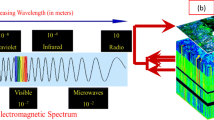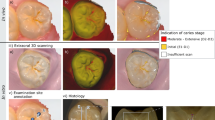Abstract
Purpose
Caries status detection and classification in its early stages is an essential process for a precise, less pain caries removal procedure. The aim of this work was to reveal and classify different caries degree status via an optical imaging system interfaced with Pc, and controlled by an inspection algorithm using DSP 6 software.
Methods
This work presents a 635-nm He-Ne laser-tissue interaction mechanism for human teeth characterization. Spectroscopic measurement for both sound and caries teeth lesion area was used to estimate the averaged optical properties. One-layer Monte Carlo model is implemented for sound, and caries lesion separately to optimize the source detector position with respect to the sample. Captured images were further processed by the designed inspection algorithm based on a Hilbert transform edge detection technique.
Results
The proposed optical imaging system was able to discriminate between the examined 12 tooth samples into sound and caries according to optical properties calculated from the spectroscopy measurements, where the reflectance, transmittance, and absorbance of the sound tooth was T n = 68%, R n = 23%, and A n = 0.47 o.d., respectively. In contrast, for caries values, T c reached 30%, R c = 5.2%, and A c = 1.6 o.d. Caries degrees inside cavity lesion were classified by the designed inspection algorithm into sound, moderate, and severe degree.
Conclusions
This study reveals the ability of the real-time, non-invasive custom optical imaging system to differentiate between sound and caries lesion teeth, in addition to classifying caries degree from images processed by the 2-D Hilbert transform inspection algorithm.





Similar content being viewed by others
References
Kockanat A, Unal M (2017) In vivo and in vitro comparison of ICDAS II, DIAGNOdent pen, CarieScan PRO and SoproLife camera for occlusal caries detection in primary molar teeth. Eur J Paediatr Dent 18(2):99–104. https://doi.org/10.23804/ejpd.2017.18.02.03
Manley EB (1946) Discussion on dental structure and dental caries. Proc R Soc Med 39:637–640
Shetty S, Bailey M (2010) A physical rendering model for human teeth. In: ACM SIGGRAPH 2010 Posters. ACM, p 116
Ten Cate A (1998) Oral histology: development, structure, and function, 5th edn. Mosby, Saint Louis Year Book, ISBN 0-8151-2952-1
Hicks J, Garcia-Godoy F, Flaitz C (2004) Biological factors in dental caries: role of remineralization and fluoride in the dynamic process of demineralization and remineralization (part 3). J Clin Pediatr Dent 28(3):203–214
Pretty IA, Ekstrand KR (2016) Detection and monitoring of early caries lesions: a review. Eur Arch Paediatr Dent 17(1):13–25. https://doi.org/10.1007/s40368-015-0208-6
Diniz MB, Lussi A, de Almeida RJ (2012) Traditional and novel caries detection methods. INTECH Open Access Publisher
El-Sharkawy YH, El Sherif AF (2012) Photoacoustic diagnosis of human teeth using interferometric detection scheme. Opt Laser Technol 44(5):1501–1506
El-Sherif AF, El-Sharkawy YH (2008) Laser-induced photothermal technique used for detection of caries in human tooth. In: Biomedical optics (BiOS) 2008. International Society for Optics and Photonics, pp 68430B-68430B-68439
Karlsson L (2010) Caries detection methods based on changes in optical properties between healthy and carious tissue. Int J Dent 2010:270729. https://doi.org/10.1155/2010/270729
Pitts NB (1997) Diagnostic tools and measurements—impact on appropriate care. Community Dent Oral Epidemiol 25(1):24–35
Fried D, Glena RE, Featherstone JD, Seka W (1995) Nature of light scattering in dental enamel and dentin at visible and near-infrared wavelengths. Appl Opt 34(7):1278–1285
Bakhmutov D, Gonchukov S, Kharchenko O, Nikiforova O, Vdovin Y (2004) Early dental caries detection by fluorescence spectroscopy. Laser Phys Lett 1(11):565
Ruohonen M, Palo K, Alander J (2013) Spectroscopic detection of caries lesions. J Med Eng 2013
Bigio IJ, Mourant JR (1997) Ultraviolet and visible spectroscopies for tissue diagnostics: fluorescence spectroscopy and elastic-scattering spectroscopy. Phys Med Biol 42(5):803
Mohanty B, Dadlani D, Mahoney D, Mann AB (2013) Characterizing and identifying incipient carious lesions in dental enamel using micro-Raman spectroscopy. Caries Res 47(1):27–33. https://doi.org/10.1159/000342432
El-Sharkawy Y (2016) Detection and characterization of human teeth caries using 2D correlation Raman spectroscopy. J Biomed Phys Eng. https://doi.org/10.22086/jbpe.v0i0.522
Parker S (2007) Laser regulation and safety in general dental practice. Br Dent J 202(9):523–532. https://doi.org/10.1038/bdj.2007.370
Wang L, Jacques SL, Zheng L (1995) MCML—Monte Carlo modeling of light transport in multi-layered tissues. Comput Methods Prog Biomed 47(2):131–146
Zonios G, Dimou A (2011) Modeling diffuse reflectance from homogeneous semi-infinite turbid media for biological tissue applications: a Monte Carlo study. Biomed Opt Express 2(12):3284–3294. https://doi.org/10.1364/boe.2.003284
Hibst R, Konig K (1994) Device for detecting dental caries. Google Patents
Juneja M, Sandhu PS (2009) Performance evaluation of edge detection techniques for images in spatial domain. Int J Comput Theory Eng 1(5):614
Bin L, Yeganeh MS (2012) Comparison for image edge detection algorithms. IOSR Journal of Comput Eng 2(6):1–4
Lee T-HH, Taipei TR (2007) Edge detection analysis. IJCSI Int J Comput Scie Issues 5 (6)
El-Sharkawy YH Image processing with the radial Hilbert transform of photo-thermal imaging for carious detection. In: Proc. of SPIE, vol, 2014. pp 89472A-89471
Wang L, Jacques SL (1992) Monte Carlo modeling of light transport in multi-layered tissues in standard C. The University of Texas MD Anderson Cancer Center, Houston
El-Sharkawy YH (2015) Design and implementation of noninvasive laser imaging system for human teeth carious detection and removal. J Dent Lasers 9(2):80
Angmar-Månsson B, Ten Bosch J (1987) Optical methods for the detection and quantification of caries. Adv Dent Res 1(1):14–20
Zakian C, Pretty I, Ellwood R (2009) Near-infrared hyperspectral imaging of teeth for dental caries detection. J Biomed Opt 14(6):064047. https://doi.org/10.1117/1.3275480
Prabhakar N, Kiran K, Kala M (2011) A review of modern non-invasive methods for caries diagnosis. Arch Oral Sci Res 1:168–177
El-Sherif AF, Gomaa W, El-Sharkawy YH Characterization, diagnosis and ablation of human teeth using blue laser at 457 nm. In: Proc. of SPIE Vol, 2014. pp 892902–892901
Acknowledgments
We are grateful for Prof. Mohamed A. Farag, College of Pharmacy, Cairo University, for editing an earlier version of this manuscript.
Author information
Authors and Affiliations
Corresponding author
Ethics declarations
Conflict of interest
I declare as the Corresponding Author of the Manuscript entitled “Classification of human teeth caries using custom non-invasive optical imaging system” that I have NO conflict of interest, as well as No affiliations with or involvement in any organization or entity with any financial interest, or non-financial interest in the subject matter or materials discussed in this manuscript.
Rights and permissions
About this article
Cite this article
Abdel Gawad, A.L., El-Sharkawy, Y.H. & El-Sherif, A.F. Classification of human teeth caries using custom non-invasive optical imaging system. Laser Dent Sci 1, 73–81 (2017). https://doi.org/10.1007/s41547-017-0008-x
Received:
Accepted:
Published:
Issue Date:
DOI: https://doi.org/10.1007/s41547-017-0008-x




